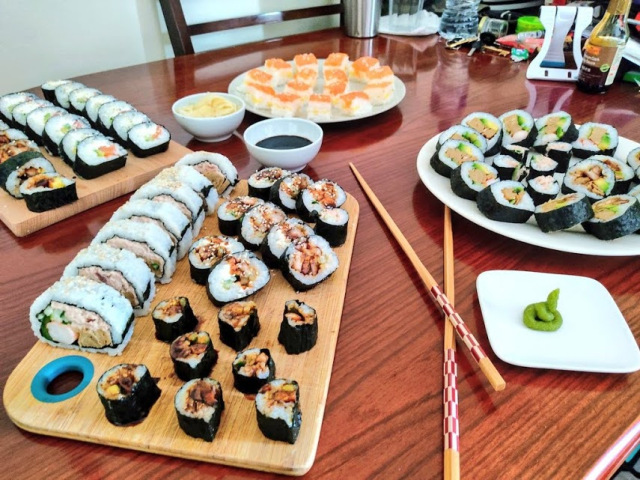With its aesthetic of beautifully presented food and the use of fresh, high-quality seasonal ingredients, it’s no wonder that Japan’s cuisine is so delicious and so highly prized by people around the world. If you’re looking to expand your knowledge of Japanese food, here are ten of the best traditional Japanese dishes.
Japanese food is one of the most popular cuisines in the world and for good reason. Based on “rules of five,” traditional Japanese cooking, or washoku, emphasizes variety and balance. This is achieved through the use of five colors (black, white, red, yellow, and green), five cooking techniques (raw food, grilling, steaming, boiling, and frying), and five flavors (sweet, spicy, salty, sour, and bitter). These principles can be found even in a single meal of one soup and three sides paired with rice,
Sushi
Sushi is, without doubt, one of the most famous foods to come from Japan. A dish that was born in ancient times, sushi originated from the process of preserving fish in fermented rice. Today it’s made with vinegared rice and fresh fish, presented in a number of ways and shapes.
Tempura
Tempura is a dish of battered and fried fish, seafood, or vegetables. Special care is given to the way the ingredients are cut as well as to the temperature of the batter (ice cold) and oil (very hot) for deep-frying, so that every piece is a bite of crisply fried perfection. In the Kanto region around Tokyo, tempura is eaten with a dipping sauce, while in the Kansai region around Kyoto and Osaka it’s dipped in flavored salt.
Yakitori
Yakitori is a dish of bite-sized cuts of chicken grilled on a skewer. It makes use of every part of the chicken — including heart, liver, and even chicken comb — to avoid wastefulness, an important element of Japanese food culture. Unlike other traditional Japanese foods, yakitori has only been eaten since around the mid-17th century, as eating meat was largely taboo in Japan for several centuries.
Tsukemono pickles
Tsukemono are traditional pickles that have been eaten in Japan since prehistoric times. Made with a wide variety of ingredients, including vegetables like daikon radish and eggplant, as well as fruits like ume plum. Tsukemono not only add visual appeal to a meal with their bright colors, they’re also an extremely healthy food.
Kaiseki
The ultimate in Japanese fine dining, kaiseki is a tasting course comprised of small, seasonally themed dishes crafted with the utmost precision and attention to detail. Kaiseki was born from the traditional tea ceremony, where small morsels of food were offered alongside the bitter green tea, and over time these offerings evolved into a multi-course haute cuisine meal.
Udon
Udon is a dense and chewy noodle made from wheat flour. It’s one of the most popular foods in Japan due to its delicious taste, inexpensive price point, and versatility – udon can be eaten hot or cold and customized with any number of toppings. There are three famous regional varieties of udon noodle: sanuki udon from Kagawa prefecture in Southwest Japan, kishimen from Nagoya in Central Japan, and inaniwa udon from Akita in Northern Japan.
Soba
Soba is another type of noodle dish that has been eaten in Japan for centuries. Made from buckwheat flour, soba has a long thin shape and firm texture and is very healthy. Like udon noodles, soba can be served in a hot broth or chilled with a dipping sauce, making it a delicious and healthy option any time of year.
Sukiyaki
Sukiyaki is a one-pot dish of beef, vegetables, and tofu cooked with a sweet soy sauce broth in a shallow cast iron pot. It became highly popular after the centuries-long ban on eating meat was lifted during the Meiji period, and is the perfect way to enjoy Japan’s incredibly rich and tender wagyu beef.
Sashimi
Centuries before Japanese people were eating sushi, they first enjoyed raw fish without the rice. While the name “sashimi” refers to any thinly sliced raw food, including raw beef (gyuu-sashi), chicken (tori-zashi), and even horse (basashi), fish and seafood are the most popular varieties.
Miso soup
Miso soup may seem deceptively simple, but it’s an essential Japanese food that’s served with any traditional meal. The soup is made from dashi stock – either fish or kelp stock – combined with miso bean paste to bring a savory umami element to any meal. Tofu and sliced green onions, as well as ingredients like fish, clams, and pork, can be added and may vary by the season.
Culture Trip launched in 2011 with a simple yet passionate mission: to inspire people to go beyond their boundaries and experience what makes a place, its people and its culture special and meaningful — and this is still in our DNA today. We are proud that, for more than a decade, millions like you have trusted our award-winning recommendations by people who deeply understand what makes certain places and communities so special.
Increasingly we believe the world needs more meaningful, real-life connections between curious travellers keen to explore the world in a more responsible way.
That is why we have intensively curated a collection of premium small-group trips as an invitation to meet and connect with new, like-minded people for once-in-a-lifetime experiences in three categories: Culture Trips, Rail Trips and Bespoke Trips. Our Trips are suitable for both solo travelers, couples and friends who want to explore the world together
.Culture Trips are deeply immersive 5 to 16 days itineraries, that combine authentic local experiences, exciting activities and 4-5* accommodation to look forward to at the end of each day. Our Rail Trips are our most planet-friendly itineraries that invite you to take the scenic route, relax whilst getting under the skin of a destination. Our Bespoke Trips are fully tailored itineraries, curated by our Travel Experts specifically for you, your friends or your family.
We know that many of you worry about the environmental impact of travel and are looking for ways of expanding horizons in ways that do minimal harm – and may even bring benefits.
We are committed to go as far as possible in curating our trips with care for the planet. That is why all of our trips are flightless in destination, fully carbon offset – and we have ambitious plans to be net zero in the very near future.






























